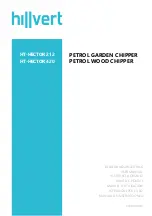
MCAC-CTSM-2018-1
Flooded type water cooled screw chiller (MIC)
5
corrosion on the internal walls and on non-protected steel surfaces.
3.
Repair safety considerations
Note:
It is compulsory to wear personal protection equipment. The insulation must be removed and
warming up must be limited using a wet cloth. Before opening the unit, ensure that the circuit has been
purged.
All installation parts must be maintained by qualified technicians, to avoid material deterioration and
injury. Faults and leaks must be repaired immediately. Authorized technician must repair faults
immediately. Each time repairs have been carried out on the unit, the safety devices must be
re-checked.
Comply with the regulations and recommendations for the unit and installation safety standards. If a
leak occurs or the refrigerant becomes contaminated (e.g. by a short circuit in a motor) remove the
complete charge using a recovery unit and store the refrigerant in mobile containers.
Repair the leak and recharge the circuit with the total R134a charge, as indicated on the unit name
plate. Certain parts of the circuit can be isolated. Only charge liquid refrigerant R134a at the liquid
line. Ensure that you use the correct refrigerant type before recharging the unit. Charging any
refrigerant other than the original charge type (R134a) will impair machine operation and can even
destroy the compressors. The compressors operating with this refrigerant type are lubricated with
synthetic oil.
Do not use oxygen to purge lines or to pressurize a machine for any reason. Oxygen gas reacts
violently with oil, grease, and other common substances.
Never exceed the specified maximum operating pressures. Verify the allowable maximum high- and
low-side test pressures by checking the instructions in this manual and the pressures given on the
unit name plate.
Do not use air for leak testing. Use only refrigerant or dry nitrogen.
Do not weld or flame cut the refrigerant lines or any refrigerant circuit component until all refrigerant
(liquid and vapor) has been removed from the chiller. Traces of vapor should be displaced with dry
air nitrogen. Refrigerant in contact with an open flame produces toxic gas.
The necessary protection equipment must be available, and appropriate fire extinguishers for the
system and refrigerant type must be within easy reach.
Do not siphon the refrigerant. Avoid spilling liquid refrigerant on your skin or splashing it into your
eyes. Use safety goggles. Wash any spills from the skin with soap and water. If liquid refrigerant
enters your eyes, immediately and abundantly flush with water and consult a doctor.
Never apply an open flame or live steam to a refrigerant container. Dangerous overpressure can
result. If it is necessary to heat the refrigerant, use warm water only.
During refrigerant removal and storage operations follow applicable regulations. These regulations,
permit the conditioning and recovery of halogenated hydrocarbons under optimum quality
conditions for the product and optimum safety conditions for people, property and the environment.
Any refrigerant transfer and recovery operations must be carried out using a transfer unit. The units







































